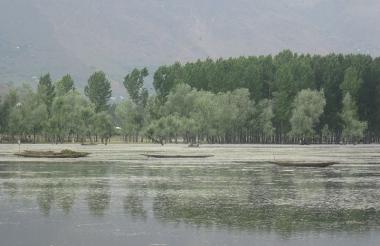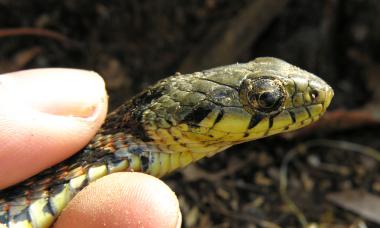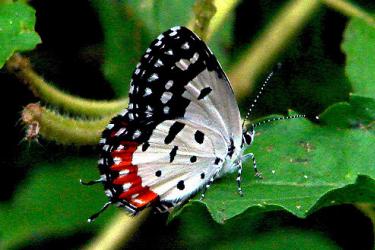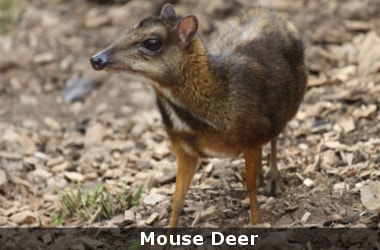▼ Willows behind Wular lake's demise, efforts on to revive largest flood basin [09-29-17]
 More than 2 million willow trees - once a key source of wood for cricket bats, fruit boxes and fires - will be cut down around Kashmir's Wular Lake, as part of efforts to revive the region's largest flood basin.
Overlooked by the Himalayas, Wular, one of Asia's biggest freshwater lakes, sits 34 km northwest of Kashmir’s summer capital, Srinagar.
Known for its deep, pristine waters, the lake has suffered extensive degradation in recent decades.
In a 2007 study, conservation group Wetlands International said the lake originally covered an area of nearly 218 square kilometres, including 58 sq km of marshland.
It shrank in size by 45% over a century - from about 158 sq km in 1911 to 87 sq km in 2007 - as it was drained for agriculture and willow plantations.
The government of Jammu and Kashmir now plans to remove some 2.1 million willows and 20 million cubic metres of silt from the lake in a conservation programme starting next month, which it says will also boost eco-tourism.
Willow planting began in Wular in 1924, mainly to provide firewood, and the plantation area was brought under Kashmir’s forest department in the 1980s.
In the 1980s and 1990s, the region's agriculture arm planted vast areas with willow as demand soared for wood to make cricket bats and fruit boxes.
But in recent years, experts have traced problems linked to heavy siltation - including less water in the lake and declining fish stocks to the presence of the willow trees.
These plantations act as a barrier to the silt-laden waters of the River Jhelum, forcing it to discharge its sediment load into the lake, thereby reducing its water-holding capacity.
Wular Conservation and Management Authority (WUCMA), said remote sensing imagery showed willow plantations extend across an area of about 27 sq km.
The trees, combined with severe siltation where they grow, have reduced the lakes capacity by one fifth.
Taking away more than 20 million cubic metres of silt would increase the depth of lake by 3.5 metres (11.5 ft).
Experts have identified some potential short-term losses from the planned conservation measures - which are due to cost INR 4.24 billion rupees ($64.5 million) - such as algae blooms caused by the release of soil nutrients into the water after the trees are felled.
But the benefits should outweigh any potential negative impacts. More than 2 million willow trees - once a key source of wood for cricket bats, fruit boxes and fires - will be cut down around Kashmir's Wular Lake, as part of efforts to revive the region's largest flood basin.
Overlooked by the Himalayas, Wular, one of Asia's biggest freshwater lakes, sits 34 km northwest of Kashmir’s summer capital, Srinagar.
Known for its deep, pristine waters, the lake has suffered extensive degradation in recent decades.
In a 2007 study, conservation group Wetlands International said the lake originally covered an area of nearly 218 square kilometres, including 58 sq km of marshland.
It shrank in size by 45% over a century - from about 158 sq km in 1911 to 87 sq km in 2007 - as it was drained for agriculture and willow plantations.
The government of Jammu and Kashmir now plans to remove some 2.1 million willows and 20 million cubic metres of silt from the lake in a conservation programme starting next month, which it says will also boost eco-tourism.
Willow planting began in Wular in 1924, mainly to provide firewood, and the plantation area was brought under Kashmir’s forest department in the 1980s.
In the 1980s and 1990s, the region's agriculture arm planted vast areas with willow as demand soared for wood to make cricket bats and fruit boxes.
But in recent years, experts have traced problems linked to heavy siltation - including less water in the lake and declining fish stocks to the presence of the willow trees.
These plantations act as a barrier to the silt-laden waters of the River Jhelum, forcing it to discharge its sediment load into the lake, thereby reducing its water-holding capacity.
Wular Conservation and Management Authority (WUCMA), said remote sensing imagery showed willow plantations extend across an area of about 27 sq km.
The trees, combined with severe siltation where they grow, have reduced the lakes capacity by one fifth.
Taking away more than 20 million cubic metres of silt would increase the depth of lake by 3.5 metres (11.5 ft).
Experts have identified some potential short-term losses from the planned conservation measures - which are due to cost INR 4.24 billion rupees ($64.5 million) - such as algae blooms caused by the release of soil nutrients into the water after the trees are felled.
But the benefits should outweigh any potential negative impacts.
|
▼ Meet Aquatic Rhabdops, the new species of non venomous snakes in northern Western Ghats [09-28-17]
 When new species of earthworms and frogs have been discovered from the Western Ghats this year, can their predators be far behind?
Scientists have described a new species of non-venomous endemic snake, Aquatic Rhabdops, from the northern Western Ghats.
The three-foot-long nocturnal snake hunts for prey underwater.
Interestingly, while adults of the Aquatic Rhabdops have off-white bellies and black spots on their olive brown skin, juveniles are olive green, with yellow undersides.
This colour difference in life stages could possibly be due to the different local habitats.
The new species is named after its aquatic nature since the adults are mostly associated with freshwater forest streams and juveniles are seen in water-logged areas, mostly on rocky plateaus.
Scientists say the new species, Rhabdops aquaticus, was till now considered a variant of the Olive Forest Snake, first described in 1863.
However, the new study confirms that the Aquatic Rhabdops is a different one: they sport not only different colours and patterns, but also vary in other features of size, shape and structure, and also genetic make-up.
Rhabdops species: Know More
Endemicity, the phenomenon of being present only in a specific geographical area, runs in the family: all Rhabdops snakes are endemic to India.
The Olive Forest Snake Rhabdops olivaceus is found only in the Western Ghats while the bi-coloured Forest Snake Rhabdops bicolour lives in a few localities in the northeast.
The Aquatic Rhabdops too is found only in the laterite plateaus of the northern Western Ghats in Goa, southern Maharashtra and northern Karnataka, in areas facing severe human pressures. When new species of earthworms and frogs have been discovered from the Western Ghats this year, can their predators be far behind?
Scientists have described a new species of non-venomous endemic snake, Aquatic Rhabdops, from the northern Western Ghats.
The three-foot-long nocturnal snake hunts for prey underwater.
Interestingly, while adults of the Aquatic Rhabdops have off-white bellies and black spots on their olive brown skin, juveniles are olive green, with yellow undersides.
This colour difference in life stages could possibly be due to the different local habitats.
The new species is named after its aquatic nature since the adults are mostly associated with freshwater forest streams and juveniles are seen in water-logged areas, mostly on rocky plateaus.
Scientists say the new species, Rhabdops aquaticus, was till now considered a variant of the Olive Forest Snake, first described in 1863.
However, the new study confirms that the Aquatic Rhabdops is a different one: they sport not only different colours and patterns, but also vary in other features of size, shape and structure, and also genetic make-up.
Rhabdops species: Know More
Endemicity, the phenomenon of being present only in a specific geographical area, runs in the family: all Rhabdops snakes are endemic to India.
The Olive Forest Snake Rhabdops olivaceus is found only in the Western Ghats while the bi-coloured Forest Snake Rhabdops bicolour lives in a few localities in the northeast.
The Aquatic Rhabdops too is found only in the laterite plateaus of the northern Western Ghats in Goa, southern Maharashtra and northern Karnataka, in areas facing severe human pressures.
|
▼ Delhi's Big Butterfly Count: 69 species spotted! [09-25-17]
 In a survey to make people aware about the ecosystem of butterflies, over 15 teams fanned out across Delhi-NCR and spotted around 69 species of butterflies.
On an average, 30 species were recorded from all locations and the highest recorded from one site was 49.
Delhi’s Big Butterfly Count initiative was led by researchers from Bombay Natural History Society (BNHS).
Butterflies are cold-blooded creatures and need sunlight for energy. They play an important role in the ecosystem. A large number of butterflies indicate a healthy environment, experts say.
The highlights of the survey were sighting of species like Psyche, Indian Red Flash, Red Pierrot, Chocolate Pansy, African Babul Blue and Painted Lady.
They were spotted after years. In our count, Psyche butterfly was recorded after three years.
Chocolate Pansy, which is normally present in humid forests, were also recorded. In addition to this, southern ridge areas were found to be especially rich in butterfly diversity.
These findings indicate that we have seen over 70 per cent of the historical record of butterfly in Delhi.
In 1986, European scientist Larsen Torben conducted a study on butterflies of Delhi, which collated historical record dating back to 1944.
He had recorded a total of 85 butterflies.
The initiative also saw butterfly enthusiasts submit the names of four butterflies - one of which will be chosen as the state butterfly of the capital.
The census was part of the butterfly month which aimed to provide an accurate and updated list of butterfly species found in the region. In a survey to make people aware about the ecosystem of butterflies, over 15 teams fanned out across Delhi-NCR and spotted around 69 species of butterflies.
On an average, 30 species were recorded from all locations and the highest recorded from one site was 49.
Delhi’s Big Butterfly Count initiative was led by researchers from Bombay Natural History Society (BNHS).
Butterflies are cold-blooded creatures and need sunlight for energy. They play an important role in the ecosystem. A large number of butterflies indicate a healthy environment, experts say.
The highlights of the survey were sighting of species like Psyche, Indian Red Flash, Red Pierrot, Chocolate Pansy, African Babul Blue and Painted Lady.
They were spotted after years. In our count, Psyche butterfly was recorded after three years.
Chocolate Pansy, which is normally present in humid forests, were also recorded. In addition to this, southern ridge areas were found to be especially rich in butterfly diversity.
These findings indicate that we have seen over 70 per cent of the historical record of butterfly in Delhi.
In 1986, European scientist Larsen Torben conducted a study on butterflies of Delhi, which collated historical record dating back to 1944.
He had recorded a total of 85 butterflies.
The initiative also saw butterfly enthusiasts submit the names of four butterflies - one of which will be chosen as the state butterfly of the capital.
The census was part of the butterfly month which aimed to provide an accurate and updated list of butterfly species found in the region.
|
▼ Octlantis - The underwater kingdom of octopuses! [09-21-17]
 Scientists have discovered Octlantis - an underwater site built entirely by octopuses, where they communicate with each other by posturing, chasing or colour changes.
Researchers found the site in the waters off the east coast of Australia, that is the home of up to 15 gloomy octopuses.
It is the second gloomy octopus settlement found in the area, and the discovery lends credence to the idea that octopuses are not necessarily loners.
The first gloomy octopus site was found in Jervis Bay off the east coast of Australia in 2009. The new site is located just a few hundred meters away from the first site, and has been dubbed Octlantis. Scientists have discovered Octlantis - an underwater site built entirely by octopuses, where they communicate with each other by posturing, chasing or colour changes.
Researchers found the site in the waters off the east coast of Australia, that is the home of up to 15 gloomy octopuses.
It is the second gloomy octopus settlement found in the area, and the discovery lends credence to the idea that octopuses are not necessarily loners.
The first gloomy octopus site was found in Jervis Bay off the east coast of Australia in 2009. The new site is located just a few hundred meters away from the first site, and has been dubbed Octlantis.
|
▼ India’s top doctors form air pollution panel [09-19-17]
 Alarmed by the growing negative impact of increasing air pollution on public health, eight of the country’s top doctors specialising in various disciplines have come together to form the Air Pollution Institute of Research (AIR) council.
The AIR council is made up of four specialists: paediatrician Dr. Bakul Parekh, chest physician Dr. Ashok Mahashur, interventional cardiologist Dr. Akshay Mehta and gynaecologist Dr. Rishma Pai.
The other four are Chennai-based paediatric pulmonologist De. Vijaya Sekaran, paediatrician Dr. Pramod Jog and interventional cardiologist Dr. Shirish Hiremath, both from Pune, and Dr. Hema Diwakar from Bangalore.
The council will endeavour to get to the root of the menace, collect data to link air pollutants to diseases, and eventually get the public and government to bring change gradually.
The doctors will be coming out with a white paper on the issue soon.
Pollutants present in the air we breathe include particulate matter, carbon monoxide, ozone, nitrogen dioxide and sulphur dioxide.
The World Health Organisation (WHO) terms air pollution as a major environmental risk to health that increases the burden of ailments such as strokes, heart disease, lung cancer, chronic and acute respiratory diseases including asthma.
In a recent report, WHO had classified New Delhi as India’s most polluted city.
An analysis by the Central Pollution Control Board averred with the WHO report, and said Mumbai ranked with Delhi as cities with the worst air quality among the 10 cities surveyed.
The AIR council aims to restrict vehicle numbers, ensure free flow of traffic, promote usage of public transport, avoid having schools near industrial areas or dumping grounds, among other objectives. Alarmed by the growing negative impact of increasing air pollution on public health, eight of the country’s top doctors specialising in various disciplines have come together to form the Air Pollution Institute of Research (AIR) council.
The AIR council is made up of four specialists: paediatrician Dr. Bakul Parekh, chest physician Dr. Ashok Mahashur, interventional cardiologist Dr. Akshay Mehta and gynaecologist Dr. Rishma Pai.
The other four are Chennai-based paediatric pulmonologist De. Vijaya Sekaran, paediatrician Dr. Pramod Jog and interventional cardiologist Dr. Shirish Hiremath, both from Pune, and Dr. Hema Diwakar from Bangalore.
The council will endeavour to get to the root of the menace, collect data to link air pollutants to diseases, and eventually get the public and government to bring change gradually.
The doctors will be coming out with a white paper on the issue soon.
Pollutants present in the air we breathe include particulate matter, carbon monoxide, ozone, nitrogen dioxide and sulphur dioxide.
The World Health Organisation (WHO) terms air pollution as a major environmental risk to health that increases the burden of ailments such as strokes, heart disease, lung cancer, chronic and acute respiratory diseases including asthma.
In a recent report, WHO had classified New Delhi as India’s most polluted city.
An analysis by the Central Pollution Control Board averred with the WHO report, and said Mumbai ranked with Delhi as cities with the worst air quality among the 10 cities surveyed.
The AIR council aims to restrict vehicle numbers, ensure free flow of traffic, promote usage of public transport, avoid having schools near industrial areas or dumping grounds, among other objectives.
|
▼ Snow Leopard no longer endangered: IUCN [09-18-17]
 The International Union of Concerned Scientists (IUCN) downlisted the Snow Leopard from its list of endangered species.
With the update to the widely cited ‘Red List’ on 14th Sept 2017 the list now includes 87,967 species of which 25,062 are threatened with extinction.
The cheerfully named Christmas Island Pipistrelle, a bat species that is found only in Australia’s Christmas Island is now officially extinct. ?
Only one individual of the species remained in 2009 and it was never found again.
One of the reasons for its disappearance was the introduction of an invasive species, the Yellow Crazy Ant into the bat’s habitat.
Snow Leopard: Know More The International Union of Concerned Scientists (IUCN) downlisted the Snow Leopard from its list of endangered species.
With the update to the widely cited ‘Red List’ on 14th Sept 2017 the list now includes 87,967 species of which 25,062 are threatened with extinction.
The cheerfully named Christmas Island Pipistrelle, a bat species that is found only in Australia’s Christmas Island is now officially extinct. ?
Only one individual of the species remained in 2009 and it was never found again.
One of the reasons for its disappearance was the introduction of an invasive species, the Yellow Crazy Ant into the bat’s habitat.
Snow Leopard: Know More
- In India, snow leopards are found in the northern stretches in Jammu and Kashmir, Himachal Pradesh, Uttarakhand and Sikkim and Arunachal Pradesh, and is a Schedule I species, enjoying the same protections as the tiger.
- The IUCN proposal was met with concern in India which hosts a population of about 400-700 with conservationists being divided about the implications of the move.
- Removal of the species from the red list indicates that their populations are rebounding, which is a positive sign.
- But some conservationists worry that downlisting the species from ‘endangered’ to only ‘vulnerable’ would signal that the species does not require the same amount of attention and resources as before.
- Some also believe that the rationale for removing the species is based on flawed data.
- Snow Leopards are very elusive species that are found at elevations of 3000-5000 metres which makes population estimations difficult.
- There are also concerns that the threats to snow leopard populations persist. These include poaching, retaliatory killing by farmers, declining prey species, shrinking habitats, and climate change.
Project Snow Leopard: Know More- In 2009, India launched Project Snow Leopard.
- Snow Leopard Project for Rs 5.15 Crores has been accepted by the MoEF, GOI commencing from 2010-11 onwards for a period of four years.
- However, interest in the project faded pretty quickly.
- The UNDP recently partnered with the environment ministry to launch the SECURE (Securing Livelihoods, Conservation, Sustainable Use and Restoration of High Range Himalayan Ecosystem) with an outlay of USD 12 million (nearly Rs 77 crore).
- Four Indian states will receive funds under the program to conserve snow leopard habitats and for protection of the species.
- India’s project snow leopard was a failure because it was never fully implemented on the ground.
- The IUCN move is not likely to change the status of the snow leopard in India.
- The government has also made a commitment towards snow leopard conservation at the recently held Bishkek forum, where 12 Snow Leopard range countries set the goal of securing 20 snow leopard landscapes by 2020.
|
▼ Mouse Deer beats extinction through human breeding programs [09-14-17]
 Mouse deer, which had become extinct in the Nalamala forests, has once again begun springing in the dense and thick bushes of the jungle after more than a decade.
Officials of the Amrabad Tiger Reserve on 12th Sept reintroduced eight mouse deer (2 males and 6 females), which were bred in captivity at the Nehru Zoological Park here for last seven years.
State forest department’s conservation breeding programme started at NZP in March 2010 with just six mouse deer (3 males and 3 females), which were brought from the Mangalore Zoo.
The numbers have swelled to 172, out of which 76 are female.
However, the animals were supposed to be released into the wild in 2013 itself.
In the last five years, many of them were dead in captivity and the lifespan of mouse deer is relatively short, with most living up to five or six years only.
The Nehru Zoological Park in association with Central Zoo Authority (CZA) and Laboratory for Conservation of Endangered Species (LaCONES) has been taken up for the conservation programme.
In order to reintroduce the mouse deer, which are bred in the NZP, a suitable location was identified in Mannanur forest range of ATR duly creating a protected enclosure, which is spread over 2.14 hectares of forest.
The enclosure has been completely protected by providing solar fence, watering facility through solar powered bore and CCTV cameras to monitor animals. Mouse deer, which had become extinct in the Nalamala forests, has once again begun springing in the dense and thick bushes of the jungle after more than a decade.
Officials of the Amrabad Tiger Reserve on 12th Sept reintroduced eight mouse deer (2 males and 6 females), which were bred in captivity at the Nehru Zoological Park here for last seven years.
State forest department’s conservation breeding programme started at NZP in March 2010 with just six mouse deer (3 males and 3 females), which were brought from the Mangalore Zoo.
The numbers have swelled to 172, out of which 76 are female.
However, the animals were supposed to be released into the wild in 2013 itself.
In the last five years, many of them were dead in captivity and the lifespan of mouse deer is relatively short, with most living up to five or six years only.
The Nehru Zoological Park in association with Central Zoo Authority (CZA) and Laboratory for Conservation of Endangered Species (LaCONES) has been taken up for the conservation programme.
In order to reintroduce the mouse deer, which are bred in the NZP, a suitable location was identified in Mannanur forest range of ATR duly creating a protected enclosure, which is spread over 2.14 hectares of forest.
The enclosure has been completely protected by providing solar fence, watering facility through solar powered bore and CCTV cameras to monitor animals.
|
▼ Mass beaching of sperm whales due to solar flares [09-6-17]
 The mass beachings of sperm whales in countries around the North Sea last year could have been due to solar storms.
Twenty-nine sperm whales washed up on German, Dutch, French and British shores between January and February 2016.
This was surprising scientists after only 82 previous beaching of sperm whales had been documented since the 1990s.
The solar storms which create the Northern Lights phenomenon could also have caused the world’s magnetic field to shift by up to 460 km (286 miles) which would interfere with the whales’ sense of orientation.
That could explain why the whales swam into the relatively shallow North Sea rather than follow their traditional routes in the Atlantic where they would find it easier to correct their direction.
If whales enter the North Sea they cannot navigate back as it’s an unnatural environment for them and very shallow. However, if they were in the Atlantic then they could. The mass beachings of sperm whales in countries around the North Sea last year could have been due to solar storms.
Twenty-nine sperm whales washed up on German, Dutch, French and British shores between January and February 2016.
This was surprising scientists after only 82 previous beaching of sperm whales had been documented since the 1990s.
The solar storms which create the Northern Lights phenomenon could also have caused the world’s magnetic field to shift by up to 460 km (286 miles) which would interfere with the whales’ sense of orientation.
That could explain why the whales swam into the relatively shallow North Sea rather than follow their traditional routes in the Atlantic where they would find it easier to correct their direction.
If whales enter the North Sea they cannot navigate back as it’s an unnatural environment for them and very shallow. However, if they were in the Atlantic then they could.
|
▼ Isha Foundation’s Sadhguru launches #RallyForRivers [09-6-17]
 Isha Foundation has a decade of experience in matters related to environment and sustainability and hence has come up with a solution to stabilise and revitalise the rivers.
To ensure that the rivers are fed by moist soil throughout the year, the campaign plans to maintain a tree cover for at least one kilometre on either side of the entire river length and of about half a kilometre for tributaries.
Forest trees will be planted on government land and fruit trees on farmer’s land.
fruit trees will help to enhance the livelihood of farmers as well as improve nutritional intake among the people.
Rally for rivers: Know More Isha Foundation has a decade of experience in matters related to environment and sustainability and hence has come up with a solution to stabilise and revitalise the rivers.
To ensure that the rivers are fed by moist soil throughout the year, the campaign plans to maintain a tree cover for at least one kilometre on either side of the entire river length and of about half a kilometre for tributaries.
Forest trees will be planted on government land and fruit trees on farmer’s land.
fruit trees will help to enhance the livelihood of farmers as well as improve nutritional intake among the people.
Rally for rivers: Know More
- The rally was flagged off on September 2 in Coimbatore and will be driving across 13 states and 22 cities in India and culminate on October 2 in Delhi.
- It will conduct over 21 events in major cities.
- The simplest way to participate in the campaign is by giving a missed call to 80009 80009.
- The missed calls will act as a vote to support the initiative.
- The rally is informational and celebratory at the same time. Artists and celebrities will also take an active part in the campaign.
- Film-stars, politicians and sportspersons have extended their support to the rally.
- Celebrities like Salman Khan, Arbaaz Khan, Anupam Kher, Rishi Kapoor, Kajal Agarwal, Ramya Krishnan, Manisha Koirala, PV Sindhu, Mithali Raj, Uma Bharti and Sonia Gandhi, among others, are urging fans and followers to support the campaign.
|
▼ Prakriti Khoj - Online environmental quiz to be launched on Teacher’s Day [09-4-17]
 The Environment Ministry will launch an environment awareness initiative, under which an online environmental quiz competition named “Prakriti Khoj”. The Environment Ministry will launch an environment awareness initiative, under which an online environmental quiz competition named “Prakriti Khoj”.
It will be an ideal medium to reach out to young minds through a fun-filled interactive learning mode to trigger their sensitivity towards environment protection and conservation.
Prakriti Khoj: Know More
- The objective of the quiz is to generate interest among school children about the science related to environment, interactions within it and the problems therein.
- The quiz is planned in two phases. For the first phase, it is envisaged that maximum number of children of schools under the National Green Corps (NGC) programme of the Ministry should get an opportunity to participate in this environmental quiz.
- Three age groups is planned to be covered in Phase-I which will be open only to Eco-clubs i.e. in the age-groups 8-12 years, 13-15 years and 16-18 years.
- A separate web portal - www.ngc.nic.in containing information on the quiz has been developed by Ministry. Dates of the quiz will be updated on the Prakriti Khoj portal, as well as the Ministry’s website.
NGC
- NGC was initiated by Ministry in 2001-02 for creating environmental awareness among children by formulating “Eco-clubs” in schools across the country.
- There are around 1,00,000 Eco-clubs across the country, making it one of the largest conservation networks, wherein students are involved in various kind of activities such as cleanliness drives, carrying out waste segregation, composting using bio-degradable wastes, subsisting the concept of three R’s, viz., Reduce, Reuse and Recycle; Nukkad Nataks etc.
|
▼ Living With Pythons: Nationwide initiative to create awareness of three python species [09-4-17]
Under an innovative initiative ‘Living with Pythons’, herpetologist and researcher Nirmal U. Kulkarni and his team are trying to address the need for a common protocol for python rescue and release.
The initiative will help address the issues relating to reptile-human conflict across the country during such rescue and release efforts.
As a first step to address this challenge, Mr. Kulkarni’s team has distributed 100 specially designed large python rescue snake bags to rescuers, forest department field staff and field researchers, across the country.
“Living with Pythons” is a nationwide initiative started to create awareness and instil appreciation about India’s three Python species.
These include the Indian Rock Python (Python molurus), Burmese Python (Python bivittatus) and Reticulated Python (Malayopython Reticulatus).
This is the first of its kind of initiative for important large snakes like the python and is the first of many initiatives that will follow as part of this project.
These bags are made of breathable cotton material and are designed for safe handling, rescue and release of large bodied snakes like pythons.
Easy to carry and wash, these bags play a major role in safety of both the snake handler as well as the snake in times of rescue as well as release of the snake.
|